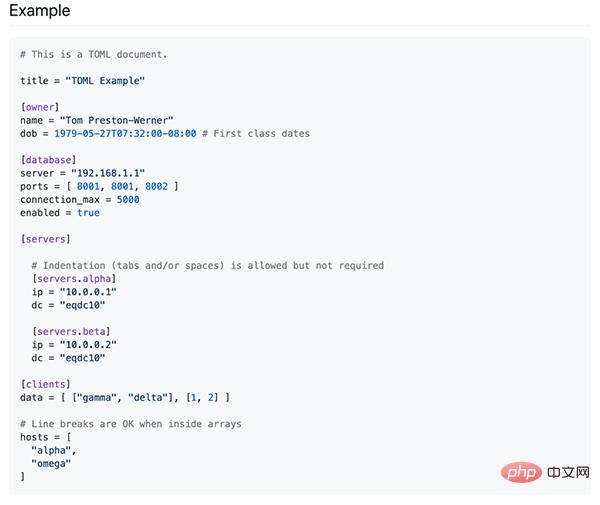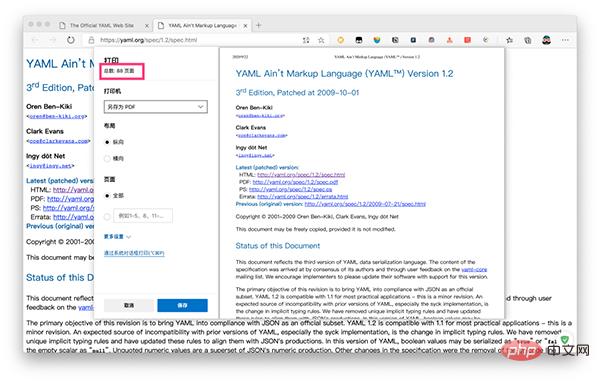 Backend Development
Backend Development
 Python Tutorial
Python Tutorial
 Super complete! Common ways to write configuration files in Python
Super complete! Common ways to write configuration files in Python
Super complete! Common ways to write configuration files in Python

Why write a configuration file
We can write this fixed file directly into a .py file, such as settings.py or config.py. The advantage of this is that it can be Under the same project, you can directly import parts of it through import; but if we need to share configuration files on other non-Python platforms, writing a single .py is not a good choice. At this time we should choose a common configuration file type to store these fixed parts. Currently, the commonly used and popular configuration file format types mainly include ini, json, toml, yaml, xml, etc. We can parse these types of configuration files through standard libraries or third-party libraries.
ini
ini means Initialize. In the early days, it was the storage format of configuration files on Windows. The writing method of ini files is easy to understand and is often relatively simple. It usually consists of section, key and value, like the following form:
[localdb] host = 127.0.0.1 user = root password = 123456 port = 3306 database = mysql
Python's own built-in configparser standard library, We can directly use it to parse the ini file. For example, we save the above content in a file named db.ini, then use the read() method to parse and read, and finally use the items() method to obtain all key-value pairs under the specified node.
>>> from configparser import ConfigParser
>>> cfg = ConfigParser()
>>> cfg.read("/Users/Bobot/db.ini")
['/Users/Bobot/db.ini']
>>> cfg.items("localdb")
[('host', '127.0.0.1'), ('user', 'root'), ('password', '123456'), ('port', '3306'), ('database', 'mysql')]It should be noted that configparser presents the value in the form of a string by default, so this is why we do not add quotation marks in the db.ini file but directly write the literal above.
After obtaining the key-value pair, I actually converted it directly into a dictionary, and then unpacked the parameters to keep the code simple:
#!pip install pymysql
import pymysql
from configparser import ConfigParser
cfg = ConfigParser()
cfg.read("/Users/Bobot/db.ini")
db_cfg = dict(cfg.items("localdb"))
con = pymysql.connect(**db_cfg)json
## The #json format can be said to be a common file format for us, and it is also a popular data exchange format on the Internet. In addition, json is sometimes also a type of configuration file. For example, npm (a JavaScript package management tool similar to Python's pip) and the widely used VSCode editor produced by Microsoft all use json to write configuration parameters. Like configparser, Python also has a built-in json standard library, which can import file and string json content through the load() and loads() methods.{
"localdb":{
"host": "127.0.0.1",
"user": "root",
"password": "123456",
"port": 3306,
"database": "mysql"
}
}>>> import json
>>> from pprint import pprint
>>>
>>> with open('/Users/Bobot/db.json') as j:
... cfg = json.load(j)['localdb']
...
>>> pprint(cfg)
{'database': 'mysql',
'host': '127.0.0.1',
'password': '123456',
'port': 3306,
'user': 'root'}
pip install toml
[mysql] host = "127.0.0.1" user = "root" port = 3306 database = "test" [mysql.parameters] pool_size = 5 charset = "utf8" [mysql.fields] pandas_cols = [ "id", "name", "age", "date"]
>>> import toml
>>> import os
>>> from pprint import pprint
>>> cfg = toml.load(os.path.expanduser("~/Desktop/config.toml"))
>>> pprint(cfg)
{'mysql': {'database': 'test',
'fields': {'pandas_cols': ['id', 'name', 'age', 'date']},
'host': '127.0.0.1',
'parameters': {'charset': 'utf8', 'pool_size': 5},
'port': 3306,
'user': 'root'}}yaml
yaml 格式(或 yml 格式)是目前较为流行的一种配置文件,它早在 2001 由一个名为 Clark Evans 的人提出;同时它也是目前被广泛使用的配置文件类型,典型的就是 Docker 容器里的 docker-compose.yml 配置文件,如果经常使用 Docker 进行部署的人对此不会陌生。
yaml 文件的设计从 Python、XML 等地方获取灵感,所以在使用时能很清楚地看到这些部分的影子。
在上一节 toml 内容里我曾提到,yaml 的规范内容可以说是冗长和复杂,足足有80页之多。

所以感兴趣的朋友可以再自行了解相关用法。
YAML 官方早已经提供了相应的 Python 库进行支持,即 PyYAML;当然也同样需要我们事先进行安装:
pip install pyyaml
同 json 库和 toml 库一样,通过 load() 方法来进行加载。
需要注意的是,使用 load() 方法会存在一定的安全隐患,从思科 Talos 的这份报告中我们可以看到,如果加载了未知或不信任的 yaml 文件,那么有可能会存在被攻击的风险和网络安全隐患,因为它能够直接调用相应的 Python 函数来执行为攻击者所需要的命令,比如说在 yaml 文件中写入这么一段:
# 使用Linux和macOS的朋友不要轻易尝试 !!python/object/apply:os.system ["rm -rf /"]
因此最好是使用 safe_load() 来代替 load() 方法。
这和 Python 内置的 string 标准库中 Template 类的 substitute() 模板方法一样存在着同样的安全隐患,所以使用 safe_substitute() 来替代是一样的道理。
如我们现在将之前的一些配置信息写入 config.yaml 文件中:
mysql: host: "127.0.0.1" port: 3306 user: "root" password: "123456" database: "test" parameter: pool_size: 5 charset: "utf8" fields: pandas_cols: - id - name - age - date
然后我们通过 safe_load() 方法进行解析:
>>> import os
>>> from pprint import pprint
>>>
>>> with open(os.path.expanduser("~/config.yaml"), "r") as config:
... cfg = yaml.safe_load(config)
...
>>> pprint(cfg)
{'mysql': {'database': 'test',
'fields': {'pandas_cols': ['id', 'name', 'age', 'date']},
'host': '127.0.0.1',
'parameter': {'charset': 'utf8', 'pool_size': 5},
'password': '123456',
'port': 3306,
'user': 'root'}}可以看到最后结果和前面的 toml 库的解析结果基本一致。
结尾
本文列举了一些主流且常见的配置文件类型及其 Python 的读取方法,可能有的读者会发现当中没有 xml 格式类型的内容。对于 xml 配置文件可能与 Java 系语言打交道的朋友遇见得会多一些,但 xml 文件的可读性实在是让人望而生畏;对 xml 文件不了解的朋友可以使用 Chrome 浏览器随便进入一个网站然后按下 F12 进入开发者后查看那密密麻麻的 html 元素便是 .xml 的缩影。
除了这些主流的配置文件类型之外,像一些 .cfg、.properties 等都可以作为配置文件,甚至和开头提到的那样,你单独用一个 .py 文件来书写各类配置信息作为配置文件进行导入都是没问题,只是在跨语言共享时可能会有些障碍。因此本文就不过多介绍,感兴趣的朋友可以进一步自行了解。
在本文里列举的配置文件类型其复杂性由上到下依次增加:ini
The above is the detailed content of Super complete! Common ways to write configuration files in Python. For more information, please follow other related articles on the PHP Chinese website!

Hot AI Tools

Undresser.AI Undress
AI-powered app for creating realistic nude photos

AI Clothes Remover
Online AI tool for removing clothes from photos.

Undress AI Tool
Undress images for free

Clothoff.io
AI clothes remover

Video Face Swap
Swap faces in any video effortlessly with our completely free AI face swap tool!

Hot Article

Hot Tools

Notepad++7.3.1
Easy-to-use and free code editor

SublimeText3 Chinese version
Chinese version, very easy to use

Zend Studio 13.0.1
Powerful PHP integrated development environment

Dreamweaver CS6
Visual web development tools

SublimeText3 Mac version
God-level code editing software (SublimeText3)

Hot Topics
 PHP and Python: Different Paradigms Explained
Apr 18, 2025 am 12:26 AM
PHP and Python: Different Paradigms Explained
Apr 18, 2025 am 12:26 AM
PHP is mainly procedural programming, but also supports object-oriented programming (OOP); Python supports a variety of paradigms, including OOP, functional and procedural programming. PHP is suitable for web development, and Python is suitable for a variety of applications such as data analysis and machine learning.
 Choosing Between PHP and Python: A Guide
Apr 18, 2025 am 12:24 AM
Choosing Between PHP and Python: A Guide
Apr 18, 2025 am 12:24 AM
PHP is suitable for web development and rapid prototyping, and Python is suitable for data science and machine learning. 1.PHP is used for dynamic web development, with simple syntax and suitable for rapid development. 2. Python has concise syntax, is suitable for multiple fields, and has a strong library ecosystem.
 Python vs. JavaScript: The Learning Curve and Ease of Use
Apr 16, 2025 am 12:12 AM
Python vs. JavaScript: The Learning Curve and Ease of Use
Apr 16, 2025 am 12:12 AM
Python is more suitable for beginners, with a smooth learning curve and concise syntax; JavaScript is suitable for front-end development, with a steep learning curve and flexible syntax. 1. Python syntax is intuitive and suitable for data science and back-end development. 2. JavaScript is flexible and widely used in front-end and server-side programming.
 Can vs code run in Windows 8
Apr 15, 2025 pm 07:24 PM
Can vs code run in Windows 8
Apr 15, 2025 pm 07:24 PM
VS Code can run on Windows 8, but the experience may not be great. First make sure the system has been updated to the latest patch, then download the VS Code installation package that matches the system architecture and install it as prompted. After installation, be aware that some extensions may be incompatible with Windows 8 and need to look for alternative extensions or use newer Windows systems in a virtual machine. Install the necessary extensions to check whether they work properly. Although VS Code is feasible on Windows 8, it is recommended to upgrade to a newer Windows system for a better development experience and security.
 Can visual studio code be used in python
Apr 15, 2025 pm 08:18 PM
Can visual studio code be used in python
Apr 15, 2025 pm 08:18 PM
VS Code can be used to write Python and provides many features that make it an ideal tool for developing Python applications. It allows users to: install Python extensions to get functions such as code completion, syntax highlighting, and debugging. Use the debugger to track code step by step, find and fix errors. Integrate Git for version control. Use code formatting tools to maintain code consistency. Use the Linting tool to spot potential problems ahead of time.
 PHP and Python: A Deep Dive into Their History
Apr 18, 2025 am 12:25 AM
PHP and Python: A Deep Dive into Their History
Apr 18, 2025 am 12:25 AM
PHP originated in 1994 and was developed by RasmusLerdorf. It was originally used to track website visitors and gradually evolved into a server-side scripting language and was widely used in web development. Python was developed by Guidovan Rossum in the late 1980s and was first released in 1991. It emphasizes code readability and simplicity, and is suitable for scientific computing, data analysis and other fields.
 How to run programs in terminal vscode
Apr 15, 2025 pm 06:42 PM
How to run programs in terminal vscode
Apr 15, 2025 pm 06:42 PM
In VS Code, you can run the program in the terminal through the following steps: Prepare the code and open the integrated terminal to ensure that the code directory is consistent with the terminal working directory. Select the run command according to the programming language (such as Python's python your_file_name.py) to check whether it runs successfully and resolve errors. Use the debugger to improve debugging efficiency.
 Is the vscode extension malicious?
Apr 15, 2025 pm 07:57 PM
Is the vscode extension malicious?
Apr 15, 2025 pm 07:57 PM
VS Code extensions pose malicious risks, such as hiding malicious code, exploiting vulnerabilities, and masturbating as legitimate extensions. Methods to identify malicious extensions include: checking publishers, reading comments, checking code, and installing with caution. Security measures also include: security awareness, good habits, regular updates and antivirus software.





